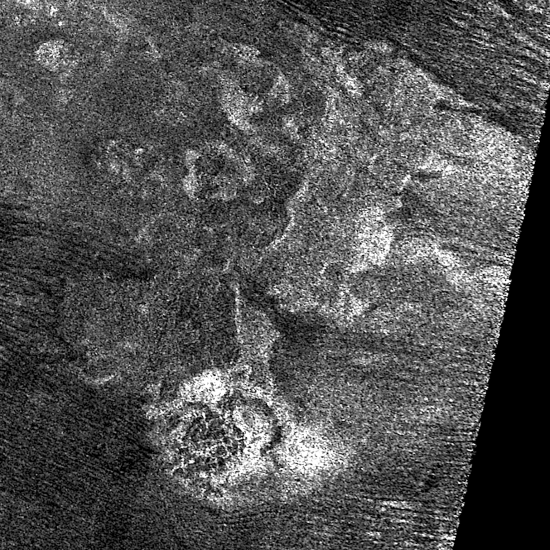
September 18, 2020
How do mountains form on frozen moons?
Titan is the fifth largest rocky body in the Solar System, with a diameter of 5150 kilometers. It is larger than Mercury (4878 kilometers), the Moon (3474 kilometers) and Pluto (2274 kilometers). Of all the planetary moons, Ganymede is only slightly larger than Titan. Titan stands out from the other planetary moons because of its atmosphere; something which Ganymede does not possess, although there is an intrinsic magnetic field on Ganymede, which does not exist on Titan.
Cassini was launched October 15, 1997 on a mission to explore Saturn and Titan, the gas giant’s largest moon. With the Huygens lander included, Cassini was the largest interplanetary space probe ever launched. It was 6.7 meters high, four meters wide and weighed 5712 kilograms on launch day. Cassini entered orbit around Saturn on June 30, 2004. Cassini explored Titan when the Huygens lander separated from the satellite and began a twenty-day journey, reaching a speed of nearly 20,000 kilometers per hour relative to the moon. The first pictures from Huygens revealed a frozen surface covered with pebbles.
Data from Cassini provided topographic information identifying large mountains on Titan. An interesting aspect to the discovery is that most of them are on the equator, near the Xanadu region. Since Titan is mountainous, researchers think that some kind of tectonic activity is taking place.
When Cassini found that Titan is rapidly losing its atmospheric methane, conventional theorists had to come up with some mechanism that would have replenished the loss over billions of years. Since astrophysicists are prone to explain the Solar System by comparing it to Earth, “interior” forces are thought to be responsible for most features on Titan, as well as erosion to sculpt them. One of the first proposals was that Titan is covered with oceans that evaporate fast enough to compensate for atmospheric loss. Most planetary scientists believe that there is methane rain on Titan, along with oceans of liquid ethane. Previous Picture of the Day articles take issue with that theory, however.
An insistence on preconceived beliefs identifies a theory in extremis. Astrophysicists “explain away” anomalous observations that are contrary to the theory rather than confront the necessity for a new theory.
The Electric Universe proposes a more general and more straightforward explanation: Titan is a “young” celestial body and has not yet reached equilibrium.
When gas giant planets experience episodes of electrical “over stress”, they might expel smaller and lumps of matter—rocky planets and moons. Over a relatively short time, electrical interactions tend to transfer energy among the planets and moons. This results in a distribution of orbits that, to gravity-only theories, appears to have been stable for eons. In an Electric Universe, many of the anomalous observations of the planets are understandable through electrical theory, without the theory having to be adjusted over and over again.
Ancient records indicate that Saturn underwent electrical fissioning events, with the possibility that Titan was expelled during those events (Saturn’s rings are also remnants). The newly minted moon was positively charged with respect to the new environment outside Saturn, so it experienced intense electrical activity after it was ejected. Electric arcs raised anode blisters, called fulgamites. Close inspection of the structures on Titan will most likely find that they have more in common with fulgamites than with tectonic activity on a dead, frozen world.
Stephen Smith
The Thunderbolts Picture of the Day is generously supported by the Mainwaring Archive Foundation.












